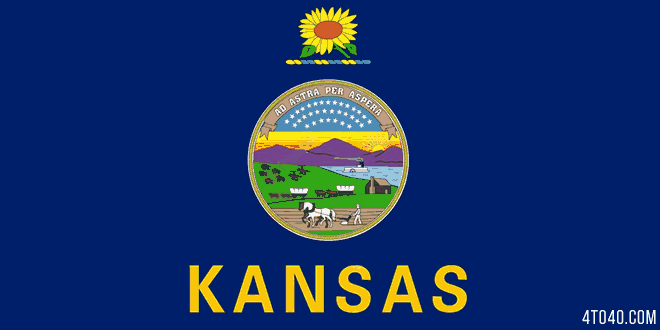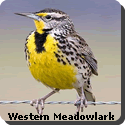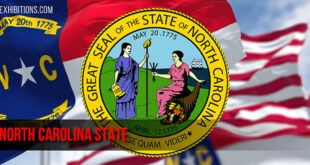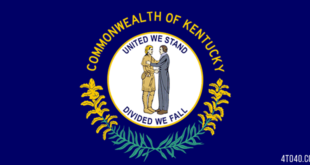Kansas occupying the central position in the conterminous United States, Kansas is one of the nation’s leading agricultural states. It is 15th in size among the states. Kansas is bordered by Nebraska, Missouri, Oklahoma, and Colorado. The area was first explored by Europeans with the Coronado expedition of 1541, but significant Anglo settlement did not occur until 1855. After a six-year struggle over the slavery issue, the “Sunflower State” entered the Union in 1861 on the free side. Today it is a prosperous, conservative, rural state with an economy well balanced between agriculture and industry. The name Kansas is a Sioux word meaning “people of the south wind“.
Kansas State: Land & Resources
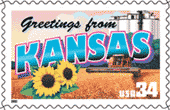
Kansas has a reputation for flat topography, but this stereotype is correct only for the western quarter of the state; most of the land is rolling and hilly. The highest point, Mount Sunflower, in Wallace County in the west, is 1,231 m (4,039 ft); the lowest elevation is 207 m (679 ft) in Montgomery County in the southeast. The rock strata are arranged in the manner of shingles. The oldest rocks, Mississippian (360-320 million-year-old) limestones, outcrop only in the southeastern corner of the state. To the west newer surface materials are found, first Pennsylvanian and Permian (320-245 million-year-old) limestones and shales, then recent Cretaceous (144-66 million-year-old) and Quaternary (less than 1.6 million-year-old) deposits. The western two-thirds of Kansas is part of the GREAT PLAINS, the eastern third belongs to the Central Lowlands, and the tiny Mississippian outcrop is part of the Ozark Upland.
The flat topography of the Great Plains is commonly attributed to a lack of water for erosion, but the recentness of surface deposits is probably a more important factor. The plains surface is actually an outwash “apron” deposited after the Rocky Mountains were uplifted. Wind-deposited soil, called loess, was placed to a depth of about one meter on top of this apron at the time of the last ice age, and it provides an excellent, stone-free medium for agriculture. Streams have dissected the plains in central Kansas to form the Blue and Smoky hills in the northern part of the area and the Gypsum Hills in the south; the latter contain scenic buttes and mesas.
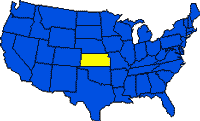 The Central Lowlands portion of Kansas is commonly divided into four subregions. South of the Kansas River are the Osage Cuestas, a plains area broken by limestone escarpments sometimes exceeding 60 m (200 ft) in height. To the west, in a belt from Washington County to Cowley County, these escarpments become bolder and more frequent. Kansans call this area the Flint Hills, a name referring to a mineral commonly found in the limestone layers. Sandstone replaces limestone in the Chautauqua Hills, a small area along the Chautauqua-Montgomery County line. North of the Kansas River is the Till Plain, where the rock escarpments are masked by a layer of glacial debris. The terrain there is gently rolling. Soils in Kansas are predominantly humus-rich mollisols, but lack of precipitation in the west limits productivity unless irrigation is available.
The Central Lowlands portion of Kansas is commonly divided into four subregions. South of the Kansas River are the Osage Cuestas, a plains area broken by limestone escarpments sometimes exceeding 60 m (200 ft) in height. To the west, in a belt from Washington County to Cowley County, these escarpments become bolder and more frequent. Kansans call this area the Flint Hills, a name referring to a mineral commonly found in the limestone layers. Sandstone replaces limestone in the Chautauqua Hills, a small area along the Chautauqua-Montgomery County line. North of the Kansas River is the Till Plain, where the rock escarpments are masked by a layer of glacial debris. The terrain there is gently rolling. Soils in Kansas are predominantly humus-rich mollisols, but lack of precipitation in the west limits productivity unless irrigation is available.
Climate:
Kansas’s “big sky,” dramatic sunsets, and great variability in temperature and precipitation are all important aspects of the regional personality. Because the state is remote from the moderating influences of oceans, it has a wide annual temperature range. The average January temperature is minus 1 deg C (30 deg F); the July average is 26 deg C (79 deg F). Diurnal ranges are also broad. Precipitation is highly variable and has a marked regional pattern. Average rainfall increases from 380 mm (15 in) in the extreme west to 1,140 mm (45 in) in the southeast, a pattern related to distance from the Gulf of Mexico moisture source. About 75% of the annual precipitation falls between April and September, but summer is often a moisture-deficient season because of high evaporation rates. Because precipitation is dependent on the chance meeting of moist air from the Gulf of Mexico and low-pressure systems, yearly totals are highly variable, especially in western Kansas. Thus, the region of greatest variability coincides with that of lowest average rainfall totals, and the combination produces doubled risks for local farmers. Sharply contrasting air masses frequently clash over the Kansas plains, bringing violent weather and adding to the variability.
Tourism:
Kansas attracts some tourism dollars each year, mostly from people in transit to and from Colorado and the West. In recent years there has been a statewide debate over the merits of establishing a Prairie National Park somewhere in the Flint Hills. Proponents talk of capturing more tourist dollars and preserving a major natural ecosystem; opponents say that development would destroy the serenity of the prairie and that Kansas ranchers are already doing a good job of preserving the grasslands.
Kansas State: History
When Francisco Vasquez de CORONADO explored the area in 1541, Kansas was occupied primarily by Osage, Pawnee, and Kansa peoples. A Pueblo group, fleeing Spanish rule in New Mexico, occupied a site in western Kansas from about 1664 until 1730. (The Pueblo site and a Pawnee village in northern Kansas have now been restored.)
Kansas was part of the area claimed by France as Louisiana at the end of the 17th century. It was ceded to Spain in 1762, restored to France in 1800, and sold to the United States in 1803 in the Louisiana Purchase. Many of the famous expeditions to the West in the early 19th century passed through Kansas, including those of Zebulon Montgomery PIKE in 1806 and Stephen H. LONG in 1819-20. Reports from the Long party led to the erroneous use of the term “Great American Desert” to describe the plains region.
Primarily because of this image, Kansas was considered an unlikely place for Anglo settlement, and the government decided to use the land for reservations for displaced Indians from the East. Westward-bound migrants were passing through Kansas, however, on both the OREGON TRAIL and the SANTA FE TRAIL. Soon tremendous pressure developed to open Kansas itself for settlement, and in the early 1850s the Indians were moved to what became Oklahoma. Four small reservations in northeast Kansas are relics from that earlier time: the Potawatomi, the Kickapoo, the Iowa, and the Sac-Fox.
The U.S. government opened Kansas to settlement in 1854 under the terms of the KANSAS-NEBRASKA ACT, which allowed the territory to determine its own position on slavery. The peopling of Kansas thus immediately became a national issue. Organizations like the EMIGRANT AID COMPANY promoted immigration by antislavery Northerners, while proslavery groups mounted a similar drive. The two groups of settlers established rival governments, violence erupted, and the territory soon became known as “Bleeding Kansas.” After much controversy within both the territory and the U.S. Congress, the proposed proslavery LECOMPTON CONSTITUTION was rejected by the electorate, and Kansas entered the Union in 1861 under the terms of the Wyandotte Constitution (1859). Guerrilla raids continued along the Missouri-Kansas border throughout the Civil War.
A major land boom occurred in the 1870s, as adequate rainfall, good soil, postwar mobility, and rapidly expanding railroads brought thousands to the state, including many immigrants from Germany, Sweden, Russia, and elsewhere. One group, the German-Russian Mennonites, introduced the hard winter wheat that transformed Kansas agriculture.
Settlers dealt with the dry Western environment much as they had with the humid East, plowing the land and establishing small farms. Ranching was viewed as an undesirable, seminomadic way of life, and so small farms were extended westward. Tree planting was thought to increase rainfall because leaves would transpire large amounts of water into the atmosphere; irrigation was believed to have almost limitless potential; and techniques of dry farming were proposed to enable even the western counties to be cultivated easily. These beliefs were the products of unfounded optimism and wet years. When especially dry conditions occurred in the 1930s, widespread winds blowing across thousands of acres of nearly unprotected soil produced the infamous DUST BOWL. Since the 1930s, improved tillage techniques, enlarged landholdings, increased use of irrigation, rural-to-urban migration, and other factors have improved the situation greatly.
Nineteenth-century Kansas was noted for its activism. Abolitionist concern was followed by major involvement in the Temperance movement and Populist party. Populism ended as a formal political movement about 1900, but it brought about many innovations including federal grain inspection and stockyard regulation. More recently, the case of BROWN V. BOARD OF EDUCATION OF TOPEKA, KANSAS led to the 1954 Supreme Court ruling that racial segregation in the public schools was unconstitutional. At least one observer has called modern Kansas the “eclipsed state”, contrasting past activity with present complacency. The state is certainly conservative politically and has a net out-migration of the young and highly educated. Other Kansans, however, believe that the state possesses what many Americans value today: smaller urban centers; clean air; an emphasis on self-reliance; and a reputation for good government and progressive education.
Kansas State: Land
- Area: 213,110 sq km (82,282 sq mi); rank: 15th.
- Capital: Topeka (1990 pop., 119,883).
- Largest city: Wichita (1990 pop., 304,011).
- Counties: 105.
- Elevations: highest–1,231 m (4,039 ft), at Mount Sunflower; lowest–207 m (679 ft), at Verdigris River.
External Links:
Business Events Happening In Kansas:
- KC Holiday Boutique: Overland Park, Kansas
- Johnson County Home + Garden Show: Overland Park, Kansas
- JOCO Home + Remodeling Show: Overland Park
 Kids Portal For Parents India Kids Network
Kids Portal For Parents India Kids Network
